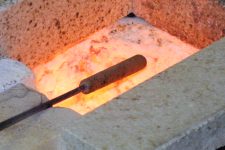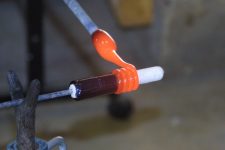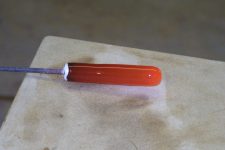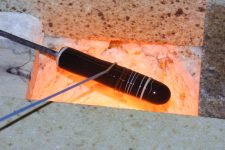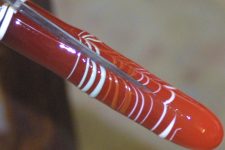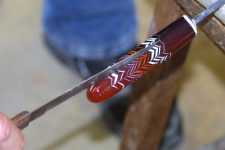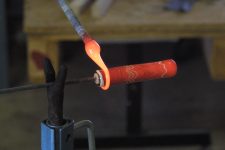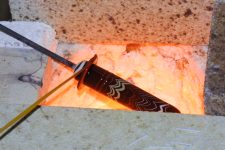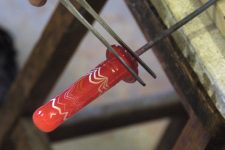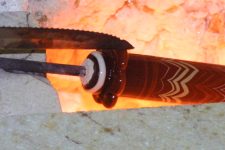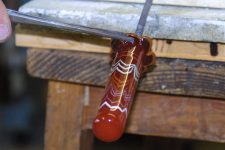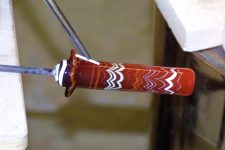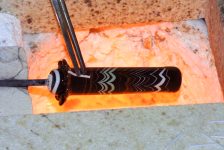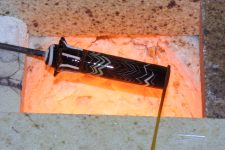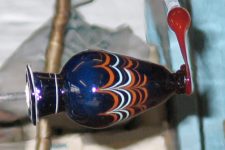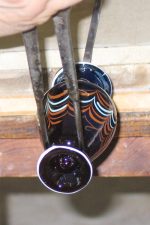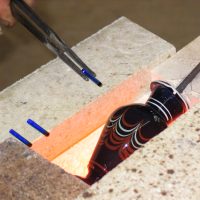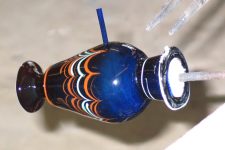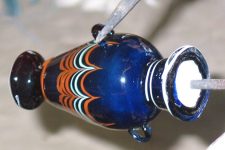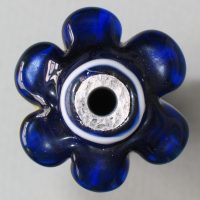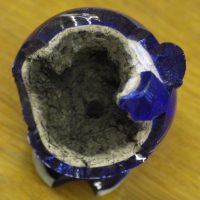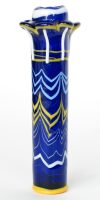ARCHIVE HOME
|
Core-formed Glass
(Photographs of the palm kohl tube being made are courtesy of Paul T. Nicholson)
|
Introduction:
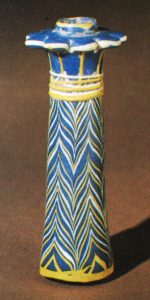
Core-forming is the process of coating a form on the end of a rod with molten glass to make a vessel. It may be decorated, and a rim, handles and a foot may be applied.
The technique is related to one of the methods of bead-making, where molten glass is wound around the tip of a mandrel to form the bead. Often, it is subsequently decorated.
The origin of core-forming is not precisely known but it is possible that it may have developed in the Kingdom of Mitanni, a Hurrian state of the mid second millenium in northern Mesopotamia and northern Syria. By the 15th century BC the technique was well established in an industry producing high-status glass ornaments and vessels in Eighteenth Dynasty Egypt, possibly introduced as a result of trade or military campaigns.
Core-forming lasted well into the Ptolemaic period, and was eventually superceded by glassblowing.
The material forming the core has been the subject of research (Bimson and Werner 1969 - two articles) and experiment (e.g. Schuler 1962, Labino 1966, Gudenrath 1991 and Stern and Schlick-Nolte 1994).
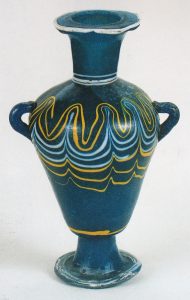
Bimson and Werner's analyses (of 62 samples) indicate that core material from 14th century Egypt is primarily a mixture of burnt out organic matter and 'a flaky mass of dark brown material' - probably very fine silt or clay, which appears to have been coated with a powdered limestone and clay (or re-used core material) slip. The outer slip may function as a release agent, easing the task of removing the core.
The evidence from later cores (two examples from Naucratis, in the Petrie Collection, dating from c.500 BC) indicates that sand was being used, possibly replacing the organic material of the earlier cores. This does not rule out the continued use of organic matter in later cores.
There are several theories regarding the methods adopted by ancient glassworkers of applying glass over the core:
-
dipping it into a suspension of powdered glass in water (Schuler)
-
coating it with crushed and powdered glass and melting it (Stern and Schlick-Nolte)
-
gathering it directly it onto the core from a pot of molten glass (Gudenrath)
-
trailing molten glass around it (Labino)
The latter two seem the most likely of these four methods, if only for speed and simplicity. Of these two, we favour trailing, as it requires smaller amounts of glass to be molten, allowing the use of smaller furnaces and allowing lower temperatures, which were perhaps more suited to ancient glassworking. Labino worked using a side entrance to his furnace, trailing the glass onto the core inside the furnace, immediately above the crucible. We work above the furnace, using the exhaust gases and radiation to heat the glass and core; or away from the furnace. This gives more control over the temperatures of the glass and core. It is also worth noting that more than one method may have been used at any one time.
Stern and Schlick-Nolte see a change, through time, in the technique for coating the core, moving from crushed glass being applied to the core in early core-forming to glass being applied as a trail in later vessels. They cite examples of trailing on the bases of two 5th and 4th century vessels and note the absence of evidence for trailing on early examples (Stern and Schlick-Nolte 1994, p.31, p.40 & ill.22, cat. nos. 43, 51).
For a detailed summary of the history and technology of glassworking during this period, see:
Nicholson, P. T. and Shaw, I. (eds.) (2000) 'Ancient Egyptian Materials and Technology' Cambridge University Press. Ch.8, 'Glass'. This book has comprehensive bibliographies on the topics covered.
For the results of analyses of Egyptian core material, see:
Bimson, M. and Werner, A. E. (1969) 'Two Problems in Ancient Glass: Opacifiers and Egyptian Core Material' in J. Philippe (ed.) 'Annales du 4th Congres International du Verre, Liege, pp. 262-266; and
Bimson, M. and Werner, A. E. (1969) 'Problems in Egyptian Core Glasses' in Charleston, R. J., Evans, W. and Werner, A. E. 'Studies in Glass History and Designs' Sheffield: Society for Glass Technology, pp. 121-122.
For practical core-forming experiments , see:
Schuler, F. (1962) 'Ancient Glassmaking Techniques. The Egyptian Core Vessel Process' in Archaeology 15, pp. 32-37.
Labino, D. (1966) 'The Egyptian Sand-core Technique: a new interpretation' in Journal of Glass Studies 8, pp. 124-127.
Gudenrath, W. (1991) 'Techniques of Glassmaking and Decoration' in Tait, H. (ed.) 'Five Thousand Years of Glass' London: British Museum Press, pp. 213-241.
Stern, E. M. and Schlick-Nolte, B. (1994) 'Early Glass of the Ancient World 1600BC - AD 50' Ostfildern: Verlag Gerd Hatje.
Our Experience:
When we were asked to demonstrate ancient core-forming for television, we had to start from the basics. After about one month of practise we reached the level where we could reproduce Egyptian New Kingdom vessels to a reasonable standard.
- The Core
The function of the core is to allow the formation of the vessel body in hot glass, whilst not breaking the vessel as it cools and anneals. After annealing, the core needs to be removed easily. The core mixture is created by mixing clay with vegetal remains (and sand) in the correct ratio(s) and shaping, drying and firing the core to about 1000°C. Vegetal matter is important, as the longer strands help to bind the mixture together firmly, it lessens the shrinkage on drying, and leaves holes in the core as it burns out on firing. This honeycombed, fired core is strong enough to withstand the glassworking stage, but weak enough to crush as the glass shrinks around it on cooling, so not breaking the vessel. When it is cold, the core can be dug out using metal tools. The low firing temperature ensures that the clay is not too vitrified, forming a relatively weakly bonded ceramic. Sand is not necessary, but it helps to reduce the shrinkage of the core on drying.
After trying several combinations of ingredients, including horse dung, grass cuttings and tea leaves, we finally settled on a mixture of clay and finely chopped (and sieved) straw, with sand as an optional ingredient.
The ingredients are measured by volume, water is added and they are mixed into a sticky, clay-like mass. This is very similar to the materials and method used by Gudenrath.
- Shaping the Core
This involves attaching a lump of the core material to the end of a metal rod and shaping it by hand and by rolling it on a flat surface (a plaster block works well). We found that cores needed to be built up in stages. First, a thin layer is attached and rolled into a cigar shape. This is dried before the next layer can be added. This may form the main body, or simply the neck, the main body being added as a third stage, depending on what type of vessel is being made.
|
The core can be made to dry very quickly without damage by putting it near a furnace for an hour or two, but is best left until the next day.
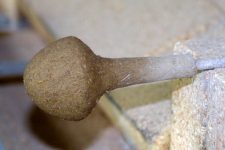
|
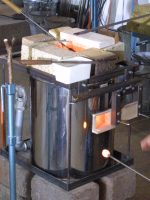
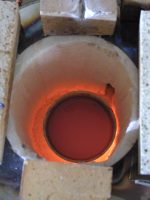
Photos above: the furnace in use. Note that it is also used to preheat the gathering irons, as well as any small lengths of glass needed for the vessel.
|
|
Making the Vessel
To make the glass vessel, a supply of molten glass is needed, together with a furnace with a hole in the top (essentially a vertically-mounted glory hole). Our furnace also contains a small pot for the glass (see photos above).
The following series of photographs show us making a reproduction of a palm kohl tube of the 18th Dynasty, with a few photographs of an amphoriskos showing a foot and a handle being applied:
The dry core is fired by placing it over the top of the furnace for about ten minutes, turning it occasionally for an even firing.
Successive gathers of molten glass are gathered from the pot and trailed around the hot core, starting from the top of the vessel and working towards the base. These are flattened and merged by using a marver or a flat hand-held metal tool, or even a dampened stone tool.
Glass of contrasting colour to that of the body (e.g. white and yellow) is applied by melting the tip of a pre-formed, thin rod, attaching it to the vessel body and turning the vessel to wind the rod around it. This is done over the furnace, and the trail width can be controlled using the heat and by varying the turning speed.
The trails are melted in and feathered using a knife blade or a metal hook.
A lip trail is added using a gather of molten glass or by applying a pre-cut length of cane (e.g. a network cane), and it can be softened and worked upon to achieve the desired shape.
Other decorations can be added, softened and shaped.
A foot is made by applying a trail, heating and shaping it.
It can also be made by casting on and shaping a small blob or gather of glass.
Handles are applied in one of two ways:
-
a pre-cut length of rod is heated and applied to the body. It is reheated, softened and looped to form a handle, and the free end is stuck to the body (see photos).
-
a small gather of glass can be applied to the body, looped around a pair of pincers, and the excess trail melted off. This is very similar to the making of "dolphin handles" on Roman oil flasks (no illustrations).
All of these processes are carried out using as low a heat as possible. The sequence in which the vessel is built is important. The base of the vessel tends to stay hotter than the neck and lip, so it is necessary to build up the top of the vessel first. This gives time for the glass at the top to melt and smooth over whilst other parts of the vessel are still being worked on.
-
The Finishing Processes The finished vessel, still on its core and rod, is annealed. When cold, the rod can be twisted free and the core carefully extracted, using a variety of purpose-made metal tools. The completeness of this process depends upon the time invested, and the accessible parts of the inside of the vessel (usually the lip and the top of the neck) can be ground and polished using sandstone and pumice.
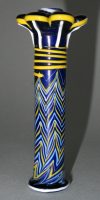
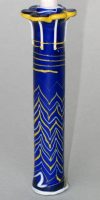
Mark Taylor and David Hill
0044 (0)1264 889688
Our new e-mail address is vitrearii @ romanglassmakers . co . uk
Unit 11, Project Workshops, Lains Farm, Quarley, Andover, Hampshire SP11 8PX, UK
Our web site is revised regularly:
www.romanglassmakers.co.uk







